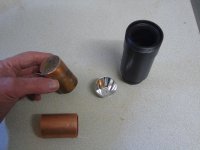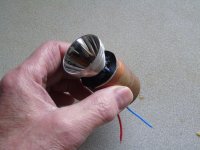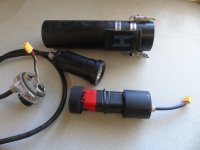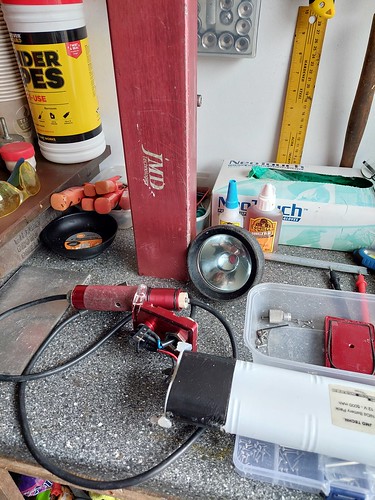royfellows
Well-known member
Peter has sent me a Halcyon diving light, as Peter describes it, "that were clearly very good bits of kit in their day, but the technology has moved on a bit since.
The lights include a depth rated battery canister capable of holding (I think) 21 18650 cells and a nicely made, depth rated light unit on a wire (see attached).
The original lamp uses 21 NiMH cells and an "HID" bulb, which is both expensive and very fragile (so not particularly suitable for UK sump diving)."
The mission is to convert this, and possibly another to modern high brightness LED - Lithium Ion battery powered
the lights appear to be extremely robust and well made, however a drawback is the 35mm internal diameter of the lamp, obviously only room of one LED with a decent beam reflector, and the rather oversize battery canister.
After some consideration I decided to go for beam quality using a large 35mm LED reflector over a Cree XHP 35 quad die emitter. This would be overdriven to 1.5 amps with a forward voltage of a tad over 12V. My lab experimentation has confirmed that this level of overdrive ( stated max 1050 mA) is safe and reliable subject to good heat dissipation, the latter being achieved by mounting on a copper base. This has been the design for my X16 caplamp, my own has been in reliable use now for 3 years. However the X16 has 2 of these.
As such, the electronics will be as used in the X16 including the battery charge control with its pretty gallium nitride green charge indicator.
The internal diameter of the lamp is good as 35mm copper pipe is readily obtainable, and highly suited to the LED module.
I will be describing the conversion blow by blow as it progresses, I know we have at least one other diver on here!
Picture shows lamp body and base module made from a section of the copper peipe. The reflector is from KD Hong Kong, they have possibly best selection on the web.
The lights include a depth rated battery canister capable of holding (I think) 21 18650 cells and a nicely made, depth rated light unit on a wire (see attached).
The original lamp uses 21 NiMH cells and an "HID" bulb, which is both expensive and very fragile (so not particularly suitable for UK sump diving)."
The mission is to convert this, and possibly another to modern high brightness LED - Lithium Ion battery powered
the lights appear to be extremely robust and well made, however a drawback is the 35mm internal diameter of the lamp, obviously only room of one LED with a decent beam reflector, and the rather oversize battery canister.
After some consideration I decided to go for beam quality using a large 35mm LED reflector over a Cree XHP 35 quad die emitter. This would be overdriven to 1.5 amps with a forward voltage of a tad over 12V. My lab experimentation has confirmed that this level of overdrive ( stated max 1050 mA) is safe and reliable subject to good heat dissipation, the latter being achieved by mounting on a copper base. This has been the design for my X16 caplamp, my own has been in reliable use now for 3 years. However the X16 has 2 of these.
As such, the electronics will be as used in the X16 including the battery charge control with its pretty gallium nitride green charge indicator.
The internal diameter of the lamp is good as 35mm copper pipe is readily obtainable, and highly suited to the LED module.
I will be describing the conversion blow by blow as it progresses, I know we have at least one other diver on here!
Picture shows lamp body and base module made from a section of the copper peipe. The reflector is from KD Hong Kong, they have possibly best selection on the web.








